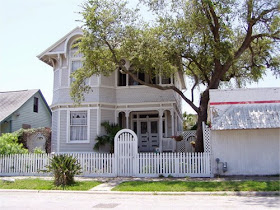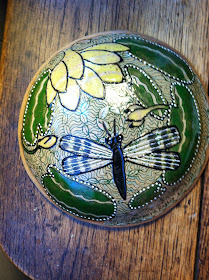Mary Baker Eddy, founder of Christian Science.
Mary Morse Baker was born in
Bow, New Hampshire, the youngest of six children of Abigail and Mark Baker. Although raised a
Congregationalist, she came to reject teachings such as
predestination and
original sin.
She suffered chronic illness and developed a strong interest in
biblical accounts of early Christian healing. At the age of eight, she
wrote, she began to hear voices calling her name.
Source:
http://en.wikipedia.org/wiki/Mary_Baker_Eddy

On December 10, 1843, Eddy married George Washington Glover.
[8] He died of
yellow fever
on June 27, 1844, a little over two months before the birth of their
only child, George Washington Glover. As a single mother of poor health,
Eddy wrote some political pieces for the New Hampshire
Patriot. She also worked as a substitute teacher in the
New Hampshire Conference Seminary.
Her success there led to her briefly opening an experimental school
which was an early attempt to introduce kindergarten methods (love
instead of harshness for discipline; interest instead of compulsion to
impart knowledge), but this, like other similar attempts at this time
was not accepted and soon closed.
[8] The social climate of the time made it very difficult for a widowed woman to earn money.
Her mother died in November 1849 and about a year later, her father married Elizabeth Patterson Duncan.
[8]
Eddy continued to have poor health and her son was put into the care of
neighbors by her father and stepmother. She married Dr. Daniel
Patterson, a dentist, in 1853, hoping he would adopt the young boy.
Patterson apparently signed papers to that effect on their wedding day,
but failed to follow through on his promise.
[9]
Eddy was often bedridden during this period. Her stepmother did not
welcome Eddy or her child. A neighbor couple with a small farm and no
children took up the care of the boy for a fee. When this couple, who
found the boy useful in the farm labor, decided to move to the Prairie
territories, without Eddy's knowledge, some of Eddy's family arranged
that the couple should take the child along with money given them by her
father. The failure of Patterson to make good on his promises of
reunification with her now far-distant son plunged Eddy into despair.
[9]
Her desire to recover her health led her to seek healing in the various
systems fashionable of the period, including electrical treatments,
morphine, homeopathy,
hydropathy,
Grahamism, and
mesmerism.
[10]
Patterson ran into financial difficulty. He mortgaged Eddy's
furniture, jewelry, and books, but was unable to keep current on their
property in
Groton, New Hampshire, and was eventually forced to vacate. Eddy's sister, Abigail, moved her to
Rumney, six miles away
After her separation from Patterson she wandered about for four years
living with different families, in Lynn, Amesbury, or some of the
neighbouring towns.
In October 1862 Eddy became a patient of
Phineas Quimby,
[32] a magnetic healer from
Maine. She benefited temporarily by his treatment.
[33] From 1862 to 1865 Quimby and Eddy engaged in lengthy discussions about healing methods practiced by Quimby and others. Phineas P.
Quimby believed in a "science of health" achieved by direct
mental healing that had religious overtones. Baker was seemingly cured,
but her suffering recurred after Quimby's death.
In 1866, she fell on
ice and her suffering increased. She turned to the
New Testament and
was suddenly healed, which led her to discover what she later called
Christian Science, or the "superiority of spiritual over physical
power."
Convinced by her own study of the Bible, especially Genesis 1, and
through experimentation, Eddy claimed to have found healing power
through a higher sense of God as Spirit and man as God's spiritual
"image and likeness." She became convinced that illness could be healed
through an awakened thought brought about by a clearer perception of God
and the explicit rejection of drugs, hygiene and medicine based upon
the observation that Jesus did not use these methods for healing:
In 1873, Eddy divorced Daniel Patterson for adultery.
In 1877 she married Asa Gilbert Eddy; in 1882 they moved to Boston, and he died that year.
In 1875, she set down her principles in a voluminous work called
Science and Health, and in 1876 founded the Christian Science Association then the
Church of Christ, Scientist (1879). She also founded the
Christian Science Publishing Society (1898), which continues to publish a number of periodicals, including
The Christian Science Monitor (1908).
In 1881, she founded the
Massachusetts Metaphysical College,
[64] where she taught approximately 800 students in Boston, Massachusetts between the years 1882 and 1889. Her students spread across the country practicing healing, and
instructing others, in accordance with Eddy's teachings. Eddy authorized
these students to list themselves as
Christian Science Practitioners in the church's periodical,
The Christian Science Journal. She also founded the
Christian Science Sentinel, a weekly magazine with articles about how to heal and testimonies of healing.
Eddy died on the evening of December 3, 1910 at her home at 400 Beacon Street, in the
Chestnut Hill section of
Newton, Massachusetts.
Today, there are almost 1,700 Christian Science churches in 76 countries.
I've copied most of this text from Wikipedia and given the link above...so all the footnotes go to the text there.
I've spoken before about my own life having been a Christian Scientist until I was 20 years old. So this woman's work greatly influenced myself and my family. I had at least 2 Christian Science Practitioners in my family.


































 one of 40 Self Portraits, 1652
one of 40 Self Portraits, 1652




